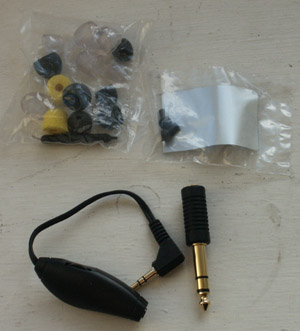Introduction
When I recently flew from Oakland to Newark to attend
my cousin’s 90th birthday luncheon, I determined to make the most
of the trip by using my Powerbook to write CD and DVD reviews in flight.
Knowing that my $49 Radio Shack headphones were not up to the task of
blocking airplane noise, I decided to audition various models of the Shure
noise-canceling earphones I’d heard so much about. My thanks to a true
gentleman, Piero Gabucci of the Secrets staff, for providing me with
distributor information, and to Shawn McLoughlin of Compass Xpress for
supplying the headphones in record time.
After soliciting opinions about the Shures from
Secrets staff members, I inferred that the higher the model number, the
deeper the bass extension. Knowing the importance of full-spectrum sound for
writing music reviews, I decided to audition both Shure's E4s and E5s.
Shure claims the E4s offer an "ultra-wide frequency
soundstage with brilliant highs and extended bass," and that the E5s offer
"extended frequency response for precise highs, natural mids, and full
bodied bass."
While the words sound pretty similar, the sound of these
earphones is miles apart. Chalk it up, in part, to the E5's separate bass
module, which adds to their size but not to their weight.
Features
Both the E4 and E5 offer a gold-plated, 3.5 mm (1/8
inch) stereo output plug. The E4, whose cable length is 157 cm (62”), comes
equipped with the PA235 level attenuator only for use when connecting
to airplane seat audio outputs. It also includes a carrying pouch, "Fit Kit"
w/cleaning tool (two each-small, medium large clear flex and soft gray flex
sleeves, one pair foam sleeves), one pair triple-flange sleeves, replacement
nozzles, and a 1/8" to ¼" mini-plug to phone-plug adapter.
The E5, whose cable length is 1.55 m (61 inches), comes
with a carrying pouch, "Fit Kit" w/cleaning tool (two each-small, medium
large clear flex and soft gray flex sleeves, one pair foam sleeves), and one
pair triple-flange sleeves. Don't ask me why, even though the E5 costs
considerably more than the E4, it doesn't include the PA235 level attenuator
nor the 1/8" to ¼" mini-plug to phone-plug adapter. [Note: This accessories
information was obtained from the brochures
supplied with the earphones. While it differs from what Shure states on its
website, it reflects what was actually included in the earphone shipment I
received.]
The Best Laid Plans of Mice and Men .
. . .
The first time I attempted to evaluate the Shure
headphones, grand plans were foiled when one of my CDs jammed in my
Powerbook's transport mechanism in-flight and the screen went dark. So much
for writing music reviews in-flight. It took Apple over three weeks to
obtain and replace my failed logic board.
Before the computer died, however, I was able to make
several major observations. Firstly, it was a challenge to find the right
way to get these earphones to stay put in my ear canals. Every ear canal is
different, so you may have an easier time inserting these babies than I did.
For me, only two positions on a 360-degree rotation work with the E5s. The
one that works best has me draping the cords over my ears, which is not easy
to arrange.
As I struggled to conquer the headphones in-flight,
cords kept tangling, and optional earpieces and volume control fell to the
floor. Trying to retrieve them from under my own feet and others' while in
coach class was not my idea of a good time. Eventually I discovered that,
for me, Shure's yellow rubber foam inserts supplied the tightest connection,
and did the best job of sealing out external noise. Note that Shure calls
these earphones "Sound Isolating", due to their acting like an earplug. They
are not active noise canceling designs.
 If
at First You Don't Succeed . . . .
If
at First You Don't Succeed . . . .
Happily, January brought a shorter flight to Las Vegas
for CES. With every seat taken and spirits geared up for a full weekend,
there was noise aplenty to mask.
Even as I sat on the floor of the Oakland airport
terminal awaiting my flight, I affirmed that the yellow foam sufficiently
insulates me from background noise. Yes, I did hear intercom announcements
and security announcements in the background, but the insulation was
sufficient to allow me to concentrate on the music at hand.
Especially if
one were listening to something like rock, where there's rarely a drop in
volume between notes, I'm convinced that the yellow foam inserts would
definitely do the trick. They couldn't block out the sound of the woman who
decided to lean over me while screaming into her cell phone, but I doubt
anything short of total annihilation would have silenced her.
I immediately heard a marked difference between the E4s
and E5s. At first, I thought the E4s sounded thin, a bit tinny, and
unquestionably bass shy. As I continued my assessment, I realized that the
E4s are quite extended on top, revealing a lot of detail that on some
recordings may register as harsh. Auditioning DVDs of historic Bell
Telephone opera broadcasts, for example, brought through the hiss loud and
clear.
Click Here to Go to Part II.